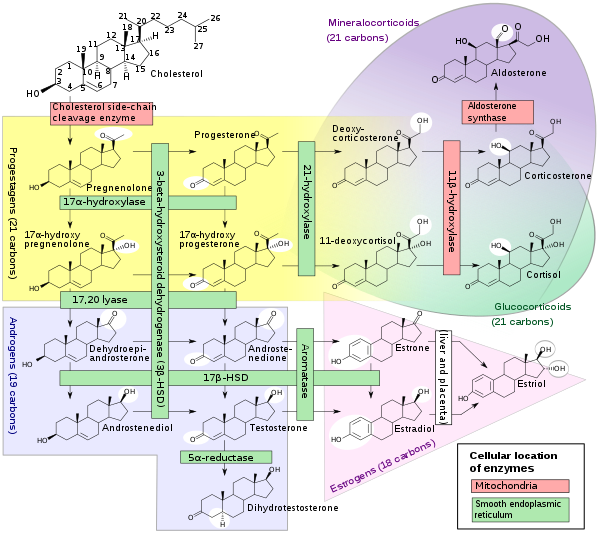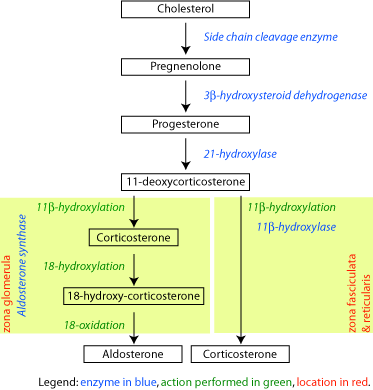3β-Hydroxysteroid dehydrogenase
3β-Hydroxysteroid dehydrogenase/Δ5-4 isomerase (3β-HSD) (EC 1.1.1.145) is an enzyme that catalyzes the biosynthesis of the steroid progesterone from pregnenolone, 17α-hydroxyprogesterone from 17α-hydroxypregnenolone, and androstenedione from dehydroepiandrosterone (DHEA) in the adrenal gland. It is the only enzyme in the adrenal pathway of corticosteroid synthesis that is not a member of the cytochrome P450 family.[1] It is also present in other steroid-producing tissues, including the ovary, testis and placenta. In humans, there are two 3β-HSD isozymes encoded by the HSD3B1 and HSD3B2 genes.
| 3β-hydroxysteroid dehydrogenase/Δ-5-4 isomerase | |||||||||
|---|---|---|---|---|---|---|---|---|---|
| Identifiers | |||||||||
| EC number | 1.1.1.145 | ||||||||
| CAS number | 9044-85-3 | ||||||||
| Databases | |||||||||
| IntEnz | IntEnz view | ||||||||
| BRENDA | BRENDA entry | ||||||||
| ExPASy | NiceZyme view | ||||||||
| KEGG | KEGG entry | ||||||||
| MetaCyc | metabolic pathway | ||||||||
| PRIAM | profile | ||||||||
| PDB structures | RCSB PDB PDBe PDBsum | ||||||||
| Gene Ontology | AmiGO / QuickGO | ||||||||
| |||||||||
| 3β-Hydroxysteroid dehydrogenase | |||||||||
|---|---|---|---|---|---|---|---|---|---|
| Identifiers | |||||||||
| Symbol | HSD3B | ||||||||
| Pfam | PF01073 | ||||||||
| InterPro | IPR002225 | ||||||||
| Membranome | 245 | ||||||||
| |||||||||
| hydroxy-Δ-5-steroid dehydrogenase, 3β- and steroid Δ-isomerase 1 | |
|---|---|
| Identifiers | |
| Symbol | HSD3B1 |
| Alt. symbols | HSDB3, HSD3B |
| NCBI gene | 3283 |
| HGNC | 5217 |
| OMIM | 109715 |
| RefSeq | NM_000862 |
| UniProt | P14060 |
| Other data | |
| EC number | 1.1.1.145 |
| Locus | Chr. 1 p13-p11 |
| hydroxy-Δ-5-steroid dehydrogenase, 3β- and steroid Δ-isomerase 2 | |
|---|---|
| Identifiers | |
| Symbol | HSD3B2 |
| NCBI gene | 3284 |
| HGNC | 5218 |
| OMIM | 613890 |
| RefSeq | NM_000198 |
| UniProt | P26439 |
| Other data | |
| EC number | 1.1.1.145 |
| Locus | Chr. 1 p13.1 |
3β-HSD is also known as delta Δ5-4-isomerase, which catalyzes the oxidative conversion of Δ5-3β-hydroxysteroids to the Δ4-3-keto configuration and is, therefore, essential for the biosynthesis of all classes of hormonal steroids, namely progesterone, glucocorticoids, mineralocorticoids, androgens, and estrogens.[2]
The 3β-HSD complex is responsible for the conversion of:
Reaction
3β-HSD belongs to the family of oxidoreductases, to be specific, those acting on the CH-OH group with NAD+ or NADP+ as acceptor. This enzyme participates in C21-steroid hormone metabolism and androgen and estrogen metabolism.
3β-HSD catalysis|catalyzes the chemical reaction:
- a 3β-hydroxy-Δ5-steroid + NAD+ ⇌ a 3-oxo-Δ5-steroid + NADH + H+
Thus, the two substrates of this enzyme are 3β-hydroxy-Δ5-steroid and NAD+, whereas its three products are 3-oxo-Δ5-steroid, NADH, and H+.
Isozymes
Humans express two 3β-HSD isozymes, HSD3B1 (type I) and HSD3B2 (type II).[3] The type I isoenzyme is expressed in placenta and peripheral tissues, whereas the type II 3β-HSD isoenzyme is expressed in the adrenal gland, ovary, and testis.
Nomenclature
The systematic name of this enzyme class is 3β-hydroxy-Δ5-steroid:NAD+ 3-oxidoreductase. Other names in common use include:
- progesterone reductase
- Δ5-3β-hydroxysteroid dehydrogenase
- 3β-hydroxy-5-ene steroid dehydrogenase
- 3β-hydroxy steroid dehydrogenase/isomerase
- 3β-hydroxy-Δ5-C27-steroid dehydrogenase/isomerase
- 3β-hydroxy-Δ5-C27-steroid oxidoreductase
- 3β-hydroxy-5-ene-steroid oxidoreductase
- steroid-Δ5-3β-ol dehydrogenase
- 3β-HSDH
- 5-ene-3β-hydroxysteroid dehydrogenase
- 3β-hydroxy-5-ene-steroid dehydrogenase
Inhibitors
3β-HSD is potently inhibited by azastene, cyanoketone, epostane, and trilostane.[4] Medroxyprogesterone acetate and medrogestone are weak inhibitors of 3β-HSD which may substantially inhibit it at high dosages.
Biosynthetic pathway
 Human steroidogenesis, showing reactions of 3β-HSD near-left in green box.
Human steroidogenesis, showing reactions of 3β-HSD near-left in green box. Corticosteroid biosynthetic pathway in the rat, showing reaction catalyzed by 3β-HSD (second arrow from the top).
Corticosteroid biosynthetic pathway in the rat, showing reaction catalyzed by 3β-HSD (second arrow from the top).
Clinical significance
A deficiency in the type II form through mutations in HSD3B2 is responsible for a rare form of congenital adrenal hyperplasia.[5] No human condition has yet been linked to a deficiency in the type I enzyme. Its importance in placental progesterone production expression suggests that such a mutation would be embryonically lethal.
The fetal adrenal cortex lacks expression of the enzyme early on, thus mineralocorticoids (e.g. aldosterone) and glucocorticoids (e.g. cortisol) cannot be synthesized. This is significant because cortisol induces type II pneumocytes of the lungs to synthesize and secrete pulmonary surfactant; without pulmonary surfactant to reduce the alveolar surface tension, premature neonates may die of neonatal respiratory distress syndrome. If delivery is unavoidable (e.g. because of placental abruption, or pre-eclampsia/HELLP syndrome), then glucocorticoids (e.g. cortisol) can be administered.
References
- Cravioto MD, Ulloa-Aguirre A, Bermudez JA, Herrera J, Lisker R, Mendez JP, Perez-Palacios G (August 1986). "A new inherited variant of the 3 beta-hydroxysteroid dehydrogenase-isomerase deficiency syndrome: evidence for the existence of two isoenzymes". J. Clin. Endocrinol. Metab. 63 (2): 360–7. doi:10.1210/jcem-63-2-360. PMID 3088022.
- Lachance Y, Luu-The V, Labrie C, Simard J, Dumont M, de Launoit Y, Guérin S, Leblanc G, Labrie F (February 1992). "Characterization of human 3 beta-hydroxysteroid dehydrogenase/delta 5-delta 4-isomerase gene and its expression in mammalian cells". J. Biol. Chem. 267 (5): 3551. PMID 1737804.
- Simard J, Ricketts ML, Gingras S, Soucy P, Feltus FA, Melner MH (June 2005). "Molecular biology of the 3beta-hydroxysteroid dehydrogenase/delta5-delta4 isomerase gene family". Endocr. Rev. 26 (4): 525–82. doi:10.1210/er.2002-0050. PMID 15632317.
- Cooke GM (April 1996). "Differential effects of trilostane and cyanoketone on the 3 beta-hydroxysteroid dehydrogenase-isomerase reactions in androgen and 16-androstene biosynthetic pathways in the pig testis". J. Steroid Biochem. Mol. Biol. 58 (1): 95–101. doi:10.1016/0960-0760(96)00002-7. PMID 8809191.
- Rhéaume E, Simard J, Morel Y, Mebarki F, Zachmann M, Forest MG, New MI, Labrie F (July 1992). "Congenital adrenal hyperplasia due to point mutations in the type II 3 beta-hydroxysteroid dehydrogenase gene". Nat. Genet. 1 (4): 239–45. doi:10.1038/ng0792-239. PMID 1363812.
Further reading
- Cheatum SG, Watten JC (1966). "Purification and properties of 3-beta-hydroxysteroid dehydrogenase and delta-5-3-ketosteroid isomerase from bovine corpora lutea". Biochim. Biophys. Acta. 122 (1): 1–13. doi:10.1016/0926-6593(66)90086-5. PMID 4226148.
- Koritz SB (1964). "The conversion of prepnenolone to progesterone by small particle from rat adrenal". Biochemistry. 3 (8): 1098–1102. doi:10.1021/bi00896a015. PMID 14220672.
- Neville AM, Orr JC, Engel LL (1968). "Delta5-3beta-Hydroxy steroid dehydrogenase activities of bovine adrenal cortex". Biochem. J. 107: 20.